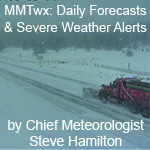- Posts: 3724
- Thank you received: 130
- Forum
- Life Up the Hill
- Scanner & Emergency Info, Weather Forecasts
- wxgeek's weather-Storm Forecast for This Week-Update 2/21
wxgeek's weather-Storm Forecast for This Week-Update 2/21
- RenegadeCJ
-
 Topic Author
Topic Author
- Mountain Legend
-

Less
More
18 Feb 2013 13:40 #1
by RenegadeCJ
Too bad future generations aren't here to see all the great things we are spending their $$ on!!
Thu Feb 21
Storm has not quite lived up to recent expectations, but at least it gave it a good try. Latest snow reports show anywhere from 1-6 inches across the Metro area and into the foothills. I have not seen any big reports that we were hoping for yesterday. Biggest sow report was outside Fairplay with 8 inches. on radar, good surge of snow moving into the Metro area and will progress into the foothills this morning, so we could see another 1/2 to 2 inches by this afternoon. Snow should gradually diminish after 10 am to noon and move farther east. Just happy to have some white stuff on the ground.
_________________
"Climatology is what you expect, Weather is what you get".
"It is better to be roughly right than precisely wrong".
Update Wed Feb 20
Models continue to suggest a better snow event for eastern CO with each run. Latest 12Z model runs have a better track for the storm, and hence better upslope and more snow for eastern CO. NWS has recently issued a Winter Storm Warning for most of eastern CO east of I-25, including the Palmer Divide, from 6 pm Wed to 5 pm Thu for 6-12 inches of snow. Winter Weather Advisory has been issued for remainder of eastern CO including the Urban Corridor and foothills from 6 pm Wed to 9 am Thu for 5-10 inches of snow. Upper level low currently near the CA/AZ border and is forecast to move east across central AZ and NM today, then head northeast into the TX panhandle and into western KS Thursday. Snow has already begun over the southwest mountains and the far eastern plains. Snow will spread into the foothills and Urban Corridor between 2 pm and 5 pm this afternoon, with snow becoming heavy at times between 5 pm and 6 am Thursday. Embedded convective cells possible, so localized thundersnow and heavy squalls possible this afternoon and evening. Based on latest data, here are my forecast snow amounts:
Southwest mountains and Sangre de Cristo mountains: 6-14 inches
Central and Northern Mountains: 5-10 inches
Foothills: 5-10 inches (up to a foot in favored areas)
Banana Belt: 3-7 inches
Palmer Divide: 6-12 inches
Urban Corridor: 4-9 inches
Eastern plains: 6-12 inches (higher amounts farther east)
Snow will persist into Thursday afternoon, but become lighter west of I-25 after 9 am Thursday morning. Heavy snow could persist across the eastern plains into Thursday evening. An even bigger snow event will take place across the central Plains of KS and NE, where up to 18 inches of snow is possible into Thursday night. Travel across eastern CO and into KS/NE will likely become impossible tonight and through most of Thursday as snow will be combined with 20-40 mph northerly winds, creating massive drifts and whiteout conditions. In general, travel will be difficult across most areas of CO tonight into Thursday morning. For today's evening commute, roads will be mostly wet up until about 5 pm, then begin to have snow and ice form on roads, so expect slick roads after 5-6 pm today. Thursday morning commute will be ugly, with nearly all roads snow and ice packed, as road crews will be kept very busy overnight, with their focus on major roadways, so minor roads may not get plowed until later on Thursday.
A big thanks to the weather gods for bringing this snow to us, we sorely need the moisture. Skies will begin to clear by late Thursday and Friday should see mostly sunny skies, except in the mountains where flurries may persist. Next weather system looks to arrive in CO Saturday night into Sunday. Still some model differences, but consensus is that snow moves into western CO late Saturday, and spreads to eastern CO Saturday night into Sunday. Currently looks like several inches possible across the foothills and plains, with a bit more in the mountains. More snow possible next week Tuesday night into Thursday morning.
_________________
"Climatology is what you expect, Weather is what you get".
"It is better to be roughly right than precisely wrong".
Update Tue Feb 19
The beauty of the weather business is that every day everything changes. So a new day, and a slightly better outlook for snow from our upcoming system. Mind you, this is NOT going to be a major snow event for the foothills or Urban Corridor, but we will at least see some snow. Latest models still bring a vigerous upper level trough down through CA today, then move it east into northern AZ/NM Wednesday, then into KS/NE on Thursday. Each model has a slightly different variation on the track and intensity, but overall they are in pretty good agreement. Surface low forms over south central CO Wednesday, and then over southeast CO Thursday morning then into the central Plains. The mountains west of the Divide and the far eastern plains still will get highest snow amounts from this system. Winter Storm Watch currently in effect for the eaastern plains, where 4-8 inches and possibly up to a foot of snow across the northeast plains is possible. Southwest mountains will be favored in this system, where 6-12 inches of snow is possible, and 5-10 inches expected over the central and northern mountains.
Latest model runs have a little better flow regime for our foothills and Urban Corridor. Flow aloft becomes southerly on Wednesday, then has an easterly component Wednesday late afternoon into Wednesday night, then becomes westerly early Thursday morning. So from Wednesday aftnoon into Thursday morning, snow will be likely across the foothills and Urban Corridor. NAM is more generous with snow than the GFS, which is unusual. So I currently expect anywhere from 2-6 inches for the foothills, and 1-4 inches for the Urban Corridor. Banana Belt areas will of course see amounts towards the low end of the range. It could also be a scenario that areas farther east receive more snow, so lower foothill elevations could get as much or more than higher elevation areas farther west. Same could hold true for the Urban Corridor, as areas farther east get higher snow amounts. Far eastern plains could see near blizzard conditions Wednesday night into Thursday as they are closer to where the surface low deepens. Also, areas of KS and NE could see 5-10 inches of snow and blizzard conditions, so travel east across the Plains could be very difficult from Wednesday afternoon into Thursday. Snow level may initially be from 5000-6000 ft Wednesday afternoon across eastern CO, so some areas could see rain, mix of rain and snow, as well as some freezing rain or drizzle initially. I expect snow to begin between 12 noon and 4 pm Wednesday across the foothills and Urban Corridor. Most initial snow should melt on roadways, but could begin to freeze by Wednesday evening as snow becomes heavier after 6 pm. Commute Thursday morning likely to be slow and slick across most roads. Travel west and east across CO even tougher, if not impossible farther east.
Snow will persist into Thursday afternoon across the eastern plains, and across the mountains west of the Divide. We should see only a few flurries Thursday in the foothills and Urban Corridor. Friday should be cool and mostly sunny, except west of the Divide where flurries will be ongoing through the day. For the weekend, significant differences now between the GFS and Euro models. GFS brings an upper trough into CO Saturday night, the Euro brings this fetaure into CO Sunday, and is deeper with the system. If the GFS is correct, snow moves into western CO Saturday afternoon, and snow spreads east Saturday night into the foothills and plains with some flurries on Sunday. Snow amounts would be a few inches in this scenario. The Euro model would bring snow into western CO Sunday morning, spreading east through the day, and persist Sunday night into Monday morning. Euro solution would have the potential for much higher snow amounts for the foothills and plains. Will have to wait and see how the models converge on thsi next system. Both models show the potential for more snow next week as well. Longer range models continue to suggest after the system next week, upper ridge builds into the western U.S. which would dry things out for a while.
_________________
"Climatology is what you expect, Weather is what you get".
"It is better to be roughly right than precisely wrong".
Normally when a storm is forecast to take the track that the system this week is forecast to take, I would be very excited about a 1-2 foot snowstorm for our foothills. Unfortunately, this year is different, so even when a storms takes a favored track, the forecast has very little snow for the foothills. Seems like we are destined to have a bad snow season this year. I apologize for my lack of optimism, but it is time to be prepared for a very bad fire season.
For this week, Tuesday looks dry and mild across the state. Storm will move down the west coast Tuesday and track east into AZ/NM on Wednesday, then into the central Plains on Thursday. The problem with this system is that it is strong along the west coast and will re-intensify in the Plains, but takes a little break as it moves across the southern Rockies. As a result, areas west of the Divide and east of I-25 will receive a fair amount of snow, but between the Divide and I-25, very little snow is currently forecast as winds remain southerly ahead of the system and then turn westerly, so no real upslope flow. Conversely, an inverted surface trough forms along the Front Range which is the kiss of death for snow for us. Forecast currently brings snow into western CO during the day on Wednesday. Snow develops across eastern CO, east of I-25, Wednesday afternoon, with snow level initially between 5000-6000 ft, lowering to plains level by Wednesday evening. Any chance for snow in the foothills and Urban Corridor will be from late Wednesday afternoon into Thursday morning, then again Thursday afternoon/evening. Mountains will see snow from Wednesday morning into Friday afternoon, heaviest snow being on Wednesday. Areas west of the Divide likely to see 5-12 inches from Wednesday to Friday. Areas east of I-25 could see 3-8 inches of snow Wednesday into Thursday, with heaviest snow being east of I-25 and north of I-70. For the foothills and Urban Corridor, looks like between 1/2 to 3 inches from Wednesday afternoon into Thursday night. This system will also bring heavy rain and snow to areas of the southern and central Plains of TX, OK, KS and NE Wednesday into Thursday, with some areas also receiving freezing rain and drizzle. Travel across western CO, as well as eastern CO and the southern/central Plains could be quite difficult at times Wednesday into Thursday night.
CO will remain under a moist northwest flow aloft regime keeping snow going in the mountains through Friday and temps at or below seasonal norms. Next system will move from the Pacific Northwest into CO on Saturday into Sunday morning. Snow will be heaviest west of the Divide where another 5-10 icnhes of snow possible, while the foothills and Urban Corridor may see a dusting to an inch or two Saturday afternoon/evening. Cold temps will exist behind this system, so Sunday expected to be cool, while snow flurries may persist in the mountains. Models then hint at another sytem moving into CO next week Monday into Tuesday. As usual, models suggesting this could be a good snow maker for eastern CO, but chances are good based on recent trends this will change towards the weekend.
So some climatology to end this report. We currently stand at 43 inches for the current snow season. Normal at the end of February is around 90 inches using the data from the Conifer Mountain almanac since 1993, and around 110 inches from my data from 2006. So we are currently around 40-46% of average snowfall. Hopefully we will add to this before the end of the month. Looking back at other dry years, at the end of February, we had 66 inches in the 1995/96 season (Buffalo Creek fire), 69 inches in the 1999/2000 season (High Meadow fire), 53 inches in 2001/02 (Hayman, Snaking, Black Mountain, Mack Gulch, Schoonover fires), 51 inches in 2008/09 (no significant fires but 73 inches of snow that April), and 149 inches in 2011/12 (Lower North Fork, High Park, Waldo Canyon, Springer fires but only 28 inches of snow March-May). Thus we are on pace to have the driest start to a snow season since 1993. However, the amount of snow we get in the March to May timeframe is probably more important than our September to February snowfall. The bad news is that the climate outlook for the March to May period is for above average temps and below average precipitation across CO and much of the Southwest. Long range numerical models are also looking dry for the first part or March, so hopes will rest on above average snow from mid March through April and May. If this does not occur which seems more likely, residents of our foothills should all be very prepared for an active and intense early fire season. Evacuation plans should be in place and understood by everyone in the family, plans with neighbors to pick up residents and pets, and have all of your important documents either stored online or copies stored in a remote safe location. I do not want to sound alarmist or paranoid, but being prepared is a requirement for those of us that live in the "Red Zone"
_________________
"Climatology is what you expect, Weather is what you get".
"It is better to be roughly right than precisely wrong".
Storm has not quite lived up to recent expectations, but at least it gave it a good try. Latest snow reports show anywhere from 1-6 inches across the Metro area and into the foothills. I have not seen any big reports that we were hoping for yesterday. Biggest sow report was outside Fairplay with 8 inches. on radar, good surge of snow moving into the Metro area and will progress into the foothills this morning, so we could see another 1/2 to 2 inches by this afternoon. Snow should gradually diminish after 10 am to noon and move farther east. Just happy to have some white stuff on the ground.
_________________
"Climatology is what you expect, Weather is what you get".
"It is better to be roughly right than precisely wrong".
Update Wed Feb 20
Models continue to suggest a better snow event for eastern CO with each run. Latest 12Z model runs have a better track for the storm, and hence better upslope and more snow for eastern CO. NWS has recently issued a Winter Storm Warning for most of eastern CO east of I-25, including the Palmer Divide, from 6 pm Wed to 5 pm Thu for 6-12 inches of snow. Winter Weather Advisory has been issued for remainder of eastern CO including the Urban Corridor and foothills from 6 pm Wed to 9 am Thu for 5-10 inches of snow. Upper level low currently near the CA/AZ border and is forecast to move east across central AZ and NM today, then head northeast into the TX panhandle and into western KS Thursday. Snow has already begun over the southwest mountains and the far eastern plains. Snow will spread into the foothills and Urban Corridor between 2 pm and 5 pm this afternoon, with snow becoming heavy at times between 5 pm and 6 am Thursday. Embedded convective cells possible, so localized thundersnow and heavy squalls possible this afternoon and evening. Based on latest data, here are my forecast snow amounts:
Southwest mountains and Sangre de Cristo mountains: 6-14 inches
Central and Northern Mountains: 5-10 inches
Foothills: 5-10 inches (up to a foot in favored areas)
Banana Belt: 3-7 inches
Palmer Divide: 6-12 inches
Urban Corridor: 4-9 inches
Eastern plains: 6-12 inches (higher amounts farther east)
Snow will persist into Thursday afternoon, but become lighter west of I-25 after 9 am Thursday morning. Heavy snow could persist across the eastern plains into Thursday evening. An even bigger snow event will take place across the central Plains of KS and NE, where up to 18 inches of snow is possible into Thursday night. Travel across eastern CO and into KS/NE will likely become impossible tonight and through most of Thursday as snow will be combined with 20-40 mph northerly winds, creating massive drifts and whiteout conditions. In general, travel will be difficult across most areas of CO tonight into Thursday morning. For today's evening commute, roads will be mostly wet up until about 5 pm, then begin to have snow and ice form on roads, so expect slick roads after 5-6 pm today. Thursday morning commute will be ugly, with nearly all roads snow and ice packed, as road crews will be kept very busy overnight, with their focus on major roadways, so minor roads may not get plowed until later on Thursday.
A big thanks to the weather gods for bringing this snow to us, we sorely need the moisture. Skies will begin to clear by late Thursday and Friday should see mostly sunny skies, except in the mountains where flurries may persist. Next weather system looks to arrive in CO Saturday night into Sunday. Still some model differences, but consensus is that snow moves into western CO late Saturday, and spreads to eastern CO Saturday night into Sunday. Currently looks like several inches possible across the foothills and plains, with a bit more in the mountains. More snow possible next week Tuesday night into Thursday morning.
_________________
"Climatology is what you expect, Weather is what you get".
"It is better to be roughly right than precisely wrong".
Update Tue Feb 19
The beauty of the weather business is that every day everything changes. So a new day, and a slightly better outlook for snow from our upcoming system. Mind you, this is NOT going to be a major snow event for the foothills or Urban Corridor, but we will at least see some snow. Latest models still bring a vigerous upper level trough down through CA today, then move it east into northern AZ/NM Wednesday, then into KS/NE on Thursday. Each model has a slightly different variation on the track and intensity, but overall they are in pretty good agreement. Surface low forms over south central CO Wednesday, and then over southeast CO Thursday morning then into the central Plains. The mountains west of the Divide and the far eastern plains still will get highest snow amounts from this system. Winter Storm Watch currently in effect for the eaastern plains, where 4-8 inches and possibly up to a foot of snow across the northeast plains is possible. Southwest mountains will be favored in this system, where 6-12 inches of snow is possible, and 5-10 inches expected over the central and northern mountains.
Latest model runs have a little better flow regime for our foothills and Urban Corridor. Flow aloft becomes southerly on Wednesday, then has an easterly component Wednesday late afternoon into Wednesday night, then becomes westerly early Thursday morning. So from Wednesday aftnoon into Thursday morning, snow will be likely across the foothills and Urban Corridor. NAM is more generous with snow than the GFS, which is unusual. So I currently expect anywhere from 2-6 inches for the foothills, and 1-4 inches for the Urban Corridor. Banana Belt areas will of course see amounts towards the low end of the range. It could also be a scenario that areas farther east receive more snow, so lower foothill elevations could get as much or more than higher elevation areas farther west. Same could hold true for the Urban Corridor, as areas farther east get higher snow amounts. Far eastern plains could see near blizzard conditions Wednesday night into Thursday as they are closer to where the surface low deepens. Also, areas of KS and NE could see 5-10 inches of snow and blizzard conditions, so travel east across the Plains could be very difficult from Wednesday afternoon into Thursday. Snow level may initially be from 5000-6000 ft Wednesday afternoon across eastern CO, so some areas could see rain, mix of rain and snow, as well as some freezing rain or drizzle initially. I expect snow to begin between 12 noon and 4 pm Wednesday across the foothills and Urban Corridor. Most initial snow should melt on roadways, but could begin to freeze by Wednesday evening as snow becomes heavier after 6 pm. Commute Thursday morning likely to be slow and slick across most roads. Travel west and east across CO even tougher, if not impossible farther east.
Snow will persist into Thursday afternoon across the eastern plains, and across the mountains west of the Divide. We should see only a few flurries Thursday in the foothills and Urban Corridor. Friday should be cool and mostly sunny, except west of the Divide where flurries will be ongoing through the day. For the weekend, significant differences now between the GFS and Euro models. GFS brings an upper trough into CO Saturday night, the Euro brings this fetaure into CO Sunday, and is deeper with the system. If the GFS is correct, snow moves into western CO Saturday afternoon, and snow spreads east Saturday night into the foothills and plains with some flurries on Sunday. Snow amounts would be a few inches in this scenario. The Euro model would bring snow into western CO Sunday morning, spreading east through the day, and persist Sunday night into Monday morning. Euro solution would have the potential for much higher snow amounts for the foothills and plains. Will have to wait and see how the models converge on thsi next system. Both models show the potential for more snow next week as well. Longer range models continue to suggest after the system next week, upper ridge builds into the western U.S. which would dry things out for a while.
_________________
"Climatology is what you expect, Weather is what you get".
"It is better to be roughly right than precisely wrong".
Normally when a storm is forecast to take the track that the system this week is forecast to take, I would be very excited about a 1-2 foot snowstorm for our foothills. Unfortunately, this year is different, so even when a storms takes a favored track, the forecast has very little snow for the foothills. Seems like we are destined to have a bad snow season this year. I apologize for my lack of optimism, but it is time to be prepared for a very bad fire season.
For this week, Tuesday looks dry and mild across the state. Storm will move down the west coast Tuesday and track east into AZ/NM on Wednesday, then into the central Plains on Thursday. The problem with this system is that it is strong along the west coast and will re-intensify in the Plains, but takes a little break as it moves across the southern Rockies. As a result, areas west of the Divide and east of I-25 will receive a fair amount of snow, but between the Divide and I-25, very little snow is currently forecast as winds remain southerly ahead of the system and then turn westerly, so no real upslope flow. Conversely, an inverted surface trough forms along the Front Range which is the kiss of death for snow for us. Forecast currently brings snow into western CO during the day on Wednesday. Snow develops across eastern CO, east of I-25, Wednesday afternoon, with snow level initially between 5000-6000 ft, lowering to plains level by Wednesday evening. Any chance for snow in the foothills and Urban Corridor will be from late Wednesday afternoon into Thursday morning, then again Thursday afternoon/evening. Mountains will see snow from Wednesday morning into Friday afternoon, heaviest snow being on Wednesday. Areas west of the Divide likely to see 5-12 inches from Wednesday to Friday. Areas east of I-25 could see 3-8 inches of snow Wednesday into Thursday, with heaviest snow being east of I-25 and north of I-70. For the foothills and Urban Corridor, looks like between 1/2 to 3 inches from Wednesday afternoon into Thursday night. This system will also bring heavy rain and snow to areas of the southern and central Plains of TX, OK, KS and NE Wednesday into Thursday, with some areas also receiving freezing rain and drizzle. Travel across western CO, as well as eastern CO and the southern/central Plains could be quite difficult at times Wednesday into Thursday night.
CO will remain under a moist northwest flow aloft regime keeping snow going in the mountains through Friday and temps at or below seasonal norms. Next system will move from the Pacific Northwest into CO on Saturday into Sunday morning. Snow will be heaviest west of the Divide where another 5-10 icnhes of snow possible, while the foothills and Urban Corridor may see a dusting to an inch or two Saturday afternoon/evening. Cold temps will exist behind this system, so Sunday expected to be cool, while snow flurries may persist in the mountains. Models then hint at another sytem moving into CO next week Monday into Tuesday. As usual, models suggesting this could be a good snow maker for eastern CO, but chances are good based on recent trends this will change towards the weekend.
So some climatology to end this report. We currently stand at 43 inches for the current snow season. Normal at the end of February is around 90 inches using the data from the Conifer Mountain almanac since 1993, and around 110 inches from my data from 2006. So we are currently around 40-46% of average snowfall. Hopefully we will add to this before the end of the month. Looking back at other dry years, at the end of February, we had 66 inches in the 1995/96 season (Buffalo Creek fire), 69 inches in the 1999/2000 season (High Meadow fire), 53 inches in 2001/02 (Hayman, Snaking, Black Mountain, Mack Gulch, Schoonover fires), 51 inches in 2008/09 (no significant fires but 73 inches of snow that April), and 149 inches in 2011/12 (Lower North Fork, High Park, Waldo Canyon, Springer fires but only 28 inches of snow March-May). Thus we are on pace to have the driest start to a snow season since 1993. However, the amount of snow we get in the March to May timeframe is probably more important than our September to February snowfall. The bad news is that the climate outlook for the March to May period is for above average temps and below average precipitation across CO and much of the Southwest. Long range numerical models are also looking dry for the first part or March, so hopes will rest on above average snow from mid March through April and May. If this does not occur which seems more likely, residents of our foothills should all be very prepared for an active and intense early fire season. Evacuation plans should be in place and understood by everyone in the family, plans with neighbors to pick up residents and pets, and have all of your important documents either stored online or copies stored in a remote safe location. I do not want to sound alarmist or paranoid, but being prepared is a requirement for those of us that live in the "Red Zone"
_________________
"Climatology is what you expect, Weather is what you get".
"It is better to be roughly right than precisely wrong".
Too bad future generations aren't here to see all the great things we are spending their $$ on!!
Please Log in or Create an account to join the conversation.
- FredHayek
-

- Mountain Legend
-

Less
More
- Posts: 28720
- Thank you received: 165
18 Feb 2013 15:12 #2
by FredHayek
Thomas Sowell: There are no solutions, just trade-offs.
Replied by FredHayek on topic wxgeek's weather-Storm Forecast for This Week-Update 2/21
Super windy today in the western suburbs today so I was hoping it would lead to a big dump of snow, hopefully you are wrong! 
Thomas Sowell: There are no solutions, just trade-offs.
Please Log in or Create an account to join the conversation.
- RenegadeCJ
-
 Topic Author
Topic Author
- Mountain Legend
-

Less
More
- Posts: 3724
- Thank you received: 130
19 Feb 2013 13:14 #3
by RenegadeCJ
Too bad future generations aren't here to see all the great things we are spending their $$ on!!
Replied by RenegadeCJ on topic wxgeek's weather-Storm Forecast for This Week-Update 2/21
Bump for Tues Feb 19th update
Too bad future generations aren't here to see all the great things we are spending their $$ on!!
Please Log in or Create an account to join the conversation.
- RenegadeCJ
-
 Topic Author
Topic Author
- Mountain Legend
-

Less
More
- Posts: 3724
- Thank you received: 130
20 Feb 2013 11:40 #4
by RenegadeCJ
Too bad future generations aren't here to see all the great things we are spending their $$ on!!
Replied by RenegadeCJ on topic wxgeek's weather-Storm Forecast for This Week-Update 2/21
Bump for Feb 20 Update
Too bad future generations aren't here to see all the great things we are spending their $$ on!!
Please Log in or Create an account to join the conversation.
- RenegadeCJ
-
 Topic Author
Topic Author
- Mountain Legend
-

Less
More
- Posts: 3724
- Thank you received: 130
21 Feb 2013 07:42 #5
by RenegadeCJ
Too bad future generations aren't here to see all the great things we are spending their $$ on!!
Replied by RenegadeCJ on topic wxgeek's weather-Storm Forecast for This Week-Update 2/21
Bump for Feb 21 Update
Too bad future generations aren't here to see all the great things we are spending their $$ on!!
Please Log in or Create an account to join the conversation.
- Forum
- Life Up the Hill
- Scanner & Emergency Info, Weather Forecasts
- wxgeek's weather-Storm Forecast for This Week-Update 2/21
Time to create page: 0.137 seconds




